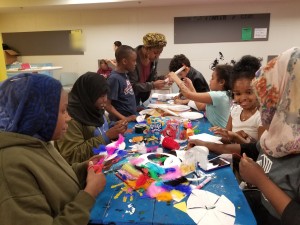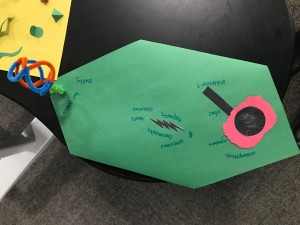While taking Technology and Social Change last semester, I had the opportunity to get a head start on this project. Below are listening methods that helped formed my design brief, and my decision to go forth with the Subscription box idea.
Historical Analysis
Through my historical analysis (an IDEO method) I was able to dig deeper into the inequalities in the public school system – a system that has a direct impact on Black and other marginalized youth’s ability to go into STEM fields. While conducting research on this system, it was evident that, as I suspected, multiple systems of discrimination and oppression are at play, at once. These systems include, but are not limited to, poverty, housing, violence, and healthcare.
Ecosystem Map
I developed a high-level ecosystem map that shows who is impacted directly and indirectly by the systemic and structural barriers to constructionism in education for Black and other marginalized youth.
Now that this has a specific focus, I plan to create another map, that is more detailed, and includes the youth at the South Boston Boys and Girls Club that I will be working with.
Contextual Inquiry
I conducted interviews with different entities from the my ecosystem map. Those people, and their current roles, are described below. The people who were interviewed are not limited in knowledge to their current positions, and were able to speak about the different parts of the ecosystem they are/were connected to.
Research Scientist at the MIT Media Lab
Education Consultant and author of the 2010 Tacoma Achievement Gap Report
Faculty member at the MIT Media Lab
Graduate student at Anglia Ruskin University
Director of the Computer Clubhouse Network
Co-Founder of Technology Access Foundation
Fulbright Fellow currently working on a STEM program for girls in Cambodia
Physics teacher at the Tacoma School of Industrial Design Engineering and Art
Clubhouse Coordinator at the Boston Computer Clubhouse
Alumni of Year Up – Seattle
Software Developer at Microsoft
Computer Science student at a community college
7th grade student aspiring to be a game designer.
Inspirational Works
My inspiration comes from the many Black women who persisted despite the systemic, structural, and social barriers they faced. Kimberlé Crenshaw’s work around intersectionality encouraged me to believe that multiple things can be true at once – in this case, multiple barriers can exist at once. The virtual community #BlackAndSTEM, created by Stephani Page, PhD has encouraged Black people in STEM academic programs and professional careers to share their experiences, and empower a new generation. Following Chanda Prescod-Weinstein, PhD on social media (and in real life) reaffirmed my experiences and desire to pursue this issue. She is the 63rd Black woman in the United States to receive a PhD in physics (there are less than 100), and she constantly speaks out about injustice through her writing. Trish Dziko, who has paved the way for Black and Brown youth to pursue STEM in Seattle for more than 20 years at Technology Access Foundation, inspired me to look more into the traditional education role in constructionism, which impacts a wider range of youth than after-school programs. Tacoma Action Collective, and their work around HIV/AIDS prevention through social justice inspired me to to think of how to approach this issue from a social justice lens.
Books that inspired my research include “Lifelong Kindergarten” by Mitch Resnick and “Why We Can’t Wait” by Martin Luther King Jr.
Below are listening methods that I have started to implement or will implement in the next few weeks with stakeholders.
Stakeholder Interviews
I began with a group stakeholder activity with the Lifelong Kindergarten research group. I started with this group, because they created the first Computer Clubhouse, and developed the four guiding principles they operate under. As a group, they identified creative learning activities, and next steps that can be paired with them. (Next steps can be college majors, summer programs, community college, technical college, four year university, etc.)
Comparative Analysis
During first semester I began doing research on who is already addressing the issue, and looked at other STEM subscription boxes. In the next few weeks, I will take a closer look at the subscription boxes and online communities for marginalized youth, to see what is already being done, and how what I want to do is different. This will allow me to identify gaps in what’s already being offered.
In addition to the methods listed above, I plan to implement the card sorting method before prototyping the online space and community.

